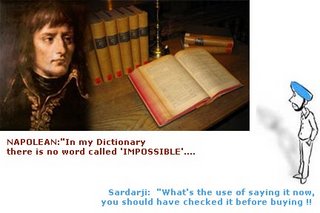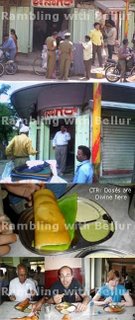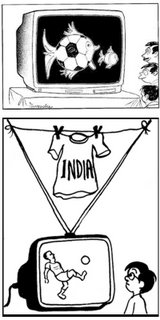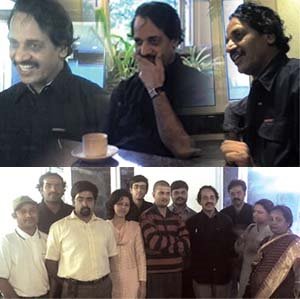On a walk last week, I met an old friend with whom I had a long chat near MES College. My son, whom I was carrying, got restless that I was 'standing' instead of 'walking'. My friend saw him and jokingly asked, "Yenappa, nim appana thara neenu Graphic Designer aagthiya?" (Will you also become a Graphic Designer like your father?) for which I replied that a son need not be like his father.
On the way back home, I remembered the story of 'Ashtavakra'. When my son asks me to tell him a bed time story, will certainly tell this one. I had read about Ashtavakra in C.Rajagopalachari's "Mahabharata". Worth recollecting the story (Rajaji's version):
While the Pandavas were wandering among holy place in the forest, they came one day to the hermitage of the personages immortalised in the Upanishads. Lomasa told Yudhishtira the story of that place.
Uddalaka, a great sage and teacher of Vedanta, had a disciple named Kagola, who was virtuous and devoted, but had no great learning. So the other disciples used to laugh and mock at him. Uddalaka, however, attached no great weight to his disciple's lack of erudition but really appreciated his virtues, devotion and good conduct and gave his daughter Sujata in marriage to him.
The couple was blessed with a son. A child generally inherits the characteristics of both parents, but fortunately the grandson of Uddalaka took after his grandfather rather than his father and knew the Vedas even while he was in his mother's womb. When Kagola made mistakes, as he often did in reciting the Vedas, the child in the womb would twist his body with pain, and so it came to pass that he had eight crooks in his body when he was born. These crooks earned him the name of 'Ashtavakra' which means eight crooks.
Kagola, one ill-fated day, provoked a polemical contest with Vandi, the court scholar of Mithila, and having been defeated, was made to drown himself.
Meanwhile Ashtavakra grew up to be a towering scholar even in his boyhood, and at the age of twelve he had already completed the study of the Vedas and the Vedanta.
One day, Ashtavakra learnt that Janaka, the king of Mithila was performing a great sacrifice in the course of which the assembled scholars would, as usual, debate on the sastras. Ashtavakra set out for Mithila, accompanied by his uncle Swetaketu.
On their way to the place of sacrifice at Mithila, they came across the king and his retinue. The attendants of the king marched in front shouting: "Move away, move away for the king." Ashtavakra instead of moving out of the way said to the retainers: " O royal attendants, even the king, if he is righteous, has to move and make way for the blind, the deformed, the fair sex, persons bearing loads and brahmanas learned in Vedas. this is the rule enjoined by the scriptures."
The king, surprised at these wise words of the brahmana boy, accepted the justness of the rebuke and made way, observing to his attendants: "What this brahmana stripling says is true. Fire is fire whether it is tiny or big and it has the power to burn."
Ashtavakra and Swetaketu entered the sacrificial hall.
The gate-keeper stopped them and said: "Boys cannot go in. Only old men learned in the Vedas may go into the sacrificial hall."
Ashtavakra replied: "We are not mere boys. We have observed the necessary vows and have learnt the Vedas. Those who have mastered the truths of the Vedanta will not judge another by mere considerations of age or appearance."
The gate-keeper said: "Stop. Have done with your idle brag. how can you, a mere boy, have learnt and realised the Vedanta?"
The boy said: "You mean I am not big like an over-grown gourd with no substance in it? Size is no indication of knowledge or worth, nor is age. A very tall old man may be a tall old fool. Let me pass."
The gate-keeper said: "You are certainly not old, nor tall, though you talk like all the hoary sages. Get out."
Ashtavakra replied: "Gate-keeper, grey hairs do not prove the ripeness of the soul. The really mature man is the one who has learnt the Vedas and the Vedangas, mastered their gist and realised their essence. I am here to meet the court pandit Vandi. Inform king Janaka of my desire."
At that moment the king himself came there and easily recognised Ashtavakra, the precociously wise boy he had met before. The king said: " Do you know that my court pandit Vandi has overthrown in argument many great scholars in the past and caused them to be cast into the ocean? Does not that deter you from this dangerous adventure?
Ashtavakra replied: "Your eminent scholar has hitherto not encountered men like me who are proficient in the Vedas or Vedanta. He has become arrogant and vain with easy victories over good men who were not real scholars. I have come here to repay the debt due on account of my father, who was defeated by this man and made to drown himself, as I have heard from my mother. I have no doubt I will vanquish Vandi, whom you will see crumple up like a broken-wheeled cart. Please summon him."
Ashtavakra met Vandi. They took up a debatable thesis and started an argument, each employing his utmost learning and wits to confound the other, and in the end the assembly unanimously declared the victory of Ashtavakra and the defeat of Vandi. The court pandit of Mithila bowed his head and paid the forfeit by drowning himself in the ocean and going to the abode of Varuna.
Then the spirit of Kagola, the father of Ashtavakra, gained peace and joy in the glory of his son. Sage Veda Vyasa instructs us through these words put in Kagola's mouth: "A son need not be like his father. A father who is physically weak may have a very strong son and an ignorant father may have a scholarly son. It is wrong to assess the greatness of a man on his physical appearance or age. External appearances are deceptive."
Which shows that the unlearned Kagola was not devoid of common-sense.
****** ****** ******
I was fortunate to have attended Swamy Paramahamsa Sri Nityananda's lectures on 'Ashtavakra Geeta' held at Bangalore's St. Joseph's auditorium (next to Mallya Hospital) in December 2005. After hearing the lecture, I was eager to read the book 'Ashtavakra Geetha'. And I could do it only a good 6 months later. Recently, I purchased the book Ashtavakra Geetha (The Song of the Self Supreme). The book opens with this paragraph:
Ashtavakra Geetha is a unique text among the world's contemplative classics dealing systematically with the mystical experiences of the Self on its way to transcendence, peace and bliss. There are few ancient treatises in East or West which evince such profound and lively concern with the Supreme Self as the ultimate reality, embodied in mystical insight and experience, and written with such spiritual imagination and poetic fervour. It may indeed be compared with the Dialogues of Plato, the Tao Teh King and the Bhagavad Geetha that all record universal insights and experiences of meditation which belong to the heritage of entire mankind.
A verse in the opening chapter of the Ashtavakra Geeta says that he who considers himself free becomes free and he who thinks he is bound remains bound. This goes to establish the proverbial saying, "As one thinks, so one becomes.'' Such a shift in focus can be brought about only when the identification with the body-mind-intellect personality is transcended. The mind is the instrument for receiving Self- knowledge. Due to ignorance it identifies with the body which is transient. One who wants to abide in the Self (Atman) has to get over this mistaken identification by rooting out everything that falls in the category of the non-Self. By constantly identifying with the Self the seeker manifests his spiritual nature.
After Ashtavakra defeated Vandi, king Janaka accepted him as his preceptor and was taught this Samhita by him. 'Ashtavakra Geetha is exclusively related to matters regarding the nature of the Self, means of realising the Self, state of mystic experience and the state of realisation in the embodied state. Throughout, it insists on detachment to worldly objects as essential to Self-realisation. One striking feature of its style is that it mostly weaves the words of the Upanishads and the Bhagavad Geetha into its verses.
Adi Sankara in his 'Viveka Choodamani' says that the body should be shunned as one would a disgusting object. This is only to reinforce the truth that the body is only an instrument and hence it should be cared for only to the extent of keeping it fit for higher pursuits. Any more attention than this will amount to obsession. The Bhagavad Geetha also points out that it is difficult to meditate on the formless Absolute for one who is centred on the body.
How is it possible to overcome the identity with the body? When we do something for someone we love there is so much spontaneity and involvement that we forget the strain on the body. So the mind has to be charged with a higher value for it to transcend identification with the body. In spiritual life the path of selfless action is a powerful tool to transcend the body identity as thoughts get vitalised when the mind is selfless and the vision then expands beyond the body. This path requires one to perform actions that have to be done but without the motive for the result. Then there will be acceptance of the outcome as divine will. There is only a thin dividing line between the attitude of escapism and acceptance. Selfless action is not escapism but total acceptance of the divine will.
There is another Geetha called 'Udhava Geetha'. It is a prose rendering based on the Sanskrit classic and Bhagavatha. Works of this kind may be needed more in future based on the other Geethas as well, as there is a great deal of interest among youth at present to go deep into Indian thought and tradition.
Udhava was an intimate friend and minister of Lord Krishna. In addition, he was a reputed student of Brihaspathi and was a great intellect. He acted as a messenger to Kamsa. Since he was aware that the Yadhava clan was going to be wiped out, he took the opportunity to clear some of his own doubts and put up about 21 questions to the Lord who answered them with clarity and authority. This portion forms the major part of the Udhava Geetha. It has about 1043 verses, which are presented in the Bhishma Parva of the Mahabharata.
I was surprised to know that as many as 45 Geethas exist, apart from Bhagavad Geetha. In the Mahabharatha, there are 16 Geethas (Manki geetha, Utathya geetha, Vaamadeva geetha, Rishabha geetha, Shadaja geetha, Sampaaka geetha, Bodhya geetha, Vichakhnu geetha, Haareetha geetha, Vritra geetha, Paraashara geetha, Hamsa geetha, Brahma geetha, Anu geetha, Braahmana geetha and Hari geetha).
Those found in Puranas - There are 20 Geethas here (2 nos. of Kapila geetha, 2 nos. of Rama geetha, 2 nos. of Brahma geetha, 3 nos. of Yama geetha and one no. of Hamsa, Bhikshu, Vaasistha, Soorya, Devi, Sootha, Shiva, Eeshwara, Vyaasa, Rudra and Ganesha geethas).
Independent works not found in any other works referred above - 4 Geethas in total (Ashtavakra geetha, Avadhootha geetha, Uttara geetha and Paandava geetha).
Those which glorify the greatness of the original Bhagavadgeetha and these come under category of ‘Geetha Maahaathmya’ - There are 5 in number and can be found in Yogavasistha, Agni Purana, Padma Purana, Vayu Purana and Varaaha Purana. Like this there are 45 Geethas in Total other than the great celestial song ‘Srimadbhagavadgeetha’.
Gita Jayanthi for the year 2006 falls on Thursday the 30th of November.
 My little fellow has fallen in love with dogs. He wants to see them all over the place all the time. As soon as you lift him, he says 'Bow bow' indicating that "take me out so that I can have the pleasure of seeing a dog." And there are plenty on our street. Some stray and some pet dogs. Some are ferocious. Some are atrocious.
A lot of cars, school vans and buses, Call-centre vehicles (usually a Sumo) comes to my street and all the stray canines just chase these out. But when the same happens to a 2 wheeler, it is very dangerous. It also happens to those walking. These dogs are posing problems for residents and 2-wheeler riders in parts of Malleswaram and Rajajinagar. It may be a problem faced by any Bangalorean, for that matter. These dogs bark at every vehicle or residents passing making life in the night an absolute nuisance. Especially, when driving in the dead of the night, one of things that most of us fear is being chased by a stray dog. The risk of meeting with an accident for a 2-wheeler rider is too high as you tend to accelerate to get the stray dog off your back. There have been number of such accidents in the past.
Jurisdictionally stray dogs are the responsibility of local corporations or CMCs. Till a few years back, stray dogs being put to death in large numbers were not unheard of in the State. But given the awareness about animal rights and a 1994 SC ruling, killing stray dogs is not a solution to the problem. And when the corporation van does come to pick them up, they go underground!
These dogs are fed by the residents on the pretext of being compassionate to animals. But when it comes to taking ownership for their road side pets, well the answer is best left unsaid. Like wise, inconsiderate neighbours house a few dogs which bark through out the night. It's a wonder how the owner sleeps.
The laws of India don't protect the common man, from such inconsiderate neighbours. Thus we are left with the option of tucking our heads under our pillows to catch some peace... "Bangalore a Pensioner's Paradise" is a dream of the past, with such nice unstoppable music playing through the night.
It seems the great dramatist TP Kailasam went to a friend's house who had a dog. Kailasam stood outside the gate as the dog kept barking. His friend told Kailasam, "Come in Kailasam, don't you know that barking dogs never bite" for which TPK said,"You and I know that. Does the dog know about it?"
Got to go on a stroll now, my little fellow is saying 'Bow bow'.
My little fellow has fallen in love with dogs. He wants to see them all over the place all the time. As soon as you lift him, he says 'Bow bow' indicating that "take me out so that I can have the pleasure of seeing a dog." And there are plenty on our street. Some stray and some pet dogs. Some are ferocious. Some are atrocious.
A lot of cars, school vans and buses, Call-centre vehicles (usually a Sumo) comes to my street and all the stray canines just chase these out. But when the same happens to a 2 wheeler, it is very dangerous. It also happens to those walking. These dogs are posing problems for residents and 2-wheeler riders in parts of Malleswaram and Rajajinagar. It may be a problem faced by any Bangalorean, for that matter. These dogs bark at every vehicle or residents passing making life in the night an absolute nuisance. Especially, when driving in the dead of the night, one of things that most of us fear is being chased by a stray dog. The risk of meeting with an accident for a 2-wheeler rider is too high as you tend to accelerate to get the stray dog off your back. There have been number of such accidents in the past.
Jurisdictionally stray dogs are the responsibility of local corporations or CMCs. Till a few years back, stray dogs being put to death in large numbers were not unheard of in the State. But given the awareness about animal rights and a 1994 SC ruling, killing stray dogs is not a solution to the problem. And when the corporation van does come to pick them up, they go underground!
These dogs are fed by the residents on the pretext of being compassionate to animals. But when it comes to taking ownership for their road side pets, well the answer is best left unsaid. Like wise, inconsiderate neighbours house a few dogs which bark through out the night. It's a wonder how the owner sleeps.
The laws of India don't protect the common man, from such inconsiderate neighbours. Thus we are left with the option of tucking our heads under our pillows to catch some peace... "Bangalore a Pensioner's Paradise" is a dream of the past, with such nice unstoppable music playing through the night.
It seems the great dramatist TP Kailasam went to a friend's house who had a dog. Kailasam stood outside the gate as the dog kept barking. His friend told Kailasam, "Come in Kailasam, don't you know that barking dogs never bite" for which TPK said,"You and I know that. Does the dog know about it?"
Got to go on a stroll now, my little fellow is saying 'Bow bow'.








